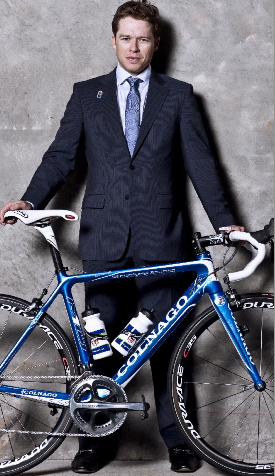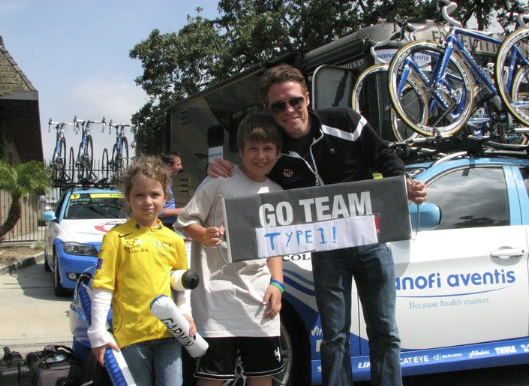Phil Southerland is a remarkable young man. He may be the youngest person ever to have been diagnosed with Type 1 diabetes (at the age of 7 months) and still be living.
Today, at 29 years old, Southerland is the founder and CEO of Team Type 1 (TT1) , a global sports organization whose Type 1 diabetic cyclists won "Race Across America" on its second attempt. He has written a memoir, "Not Dead Yet," and he's bringing diabetes heroes and supplies to children in need.
This is the 10th in my series of profiles on diabetes change leaders.

Q: What is it like to bicycle race across America, and how do you do it?
Phil Southerland: To go from one coast to the other on a bike in five days was the experience of a lifetime, and it's a logistical nightmare, which we survived due to our awesome crew chief Dave Eldridge.
We had eight riders (two teams of four), 25 support staff and two vans. Four people take off, and they're on a 6-8 hour riding shift. The first rider -- rider A -- is on the road, and three others are in what we call a "leapfrog car." Rider A takes off, and riders B, C and D go up ahead about five miles in the leapfrog car. Rider B gets out and waits for rider A. Then, rider B takes off and rider A gets in the car.
Each rider rides about fives miles. Then you ride again in about 10-15 minutes. You do this nonstop for about six hours. Meanwhile, the other four riders are in an RV traveling up ahead, and they get woken up 45 minutes before they go, eat breakfast no matter what time it is and then take over.
When you're not the riding team you have 6-8 hours of downtime. You shower -- I'm talking a little Walmart sprinkle shower with someone holding towels around you so the public can't see. You eat and try to sleep as quickly as possible, after you've just done six hours of intense anaerobic activity.
Q: As if that isn't enough, how do you do this with Type 1 diabetes?
PS: You rely on your blood sugar monitor and the trends you see on your CGM (continuous glucose monitor). With that much riding your body gets hypersensitive to insulin, so you have to test constantly. The first 2-3 days of the race we were all taking less and less insulin. At one point I was doing one unit of insulin for every 100 grams of carbohydrate -- insane.
Q:Tell me more about Team Type 1 and why you started it.
PS: We're a global sports organization of athletes including cyclists, runners and triathletes who compete across the world. Our goal is to inspire people with diabetes, to show them they can achieve their dreams if they control their blood sugar. In developing countries, we're truly trying to keep people from dying of diabetes. That means getting supplies to people in need and providing education and empowerment.
Team Type 1 started really because of my friend Joe Eldridge. When we met in college, he wasn't taking care of his diabetes. I made a bet with him to get him to do better -- higher blood sugar pays for dinner. Let's just say he bought me a lot of burritos that semester. Then the burritos stopped coming and he said, "Thank you for saving my life." That was the game changer.
Joe told me I was his hero, and I thought he could be somebody's hero, and wouldn't it be incredible to give kids heroes? Joe and I both liked biking, and I thought the bike could be a great platform for inspiring kids. When I grew up there was no one to look up to. Diabetes was a disease with no heroes. Maybe we could give kids heroes.
Q: What has TT1 accomplished in its six years?
PS: We've done some pretty impressive things, and I think we're only at the tip of the iceberg. We've shown we can compete in some of the most difficult races around the world. Also, we have an incredible partner in our sponsor, SANOFI, which has allowed us to influence policy changes around the world.
I've recently been talking with representatives from the Ministry of Health in Macedonia, and they've just committed to providing diabetes supplies to all Type 1s in Macedonia. It's not a huge number, but that's 2,500 people who are now going to have free test strips and insulin who never had them before.
In China currently, if you have Type 1 diabetes you can't go to school or get a job. After a recent long and heated meeting in Nanjing, the governnment is going to begin abolishing the discrimination laws there so people with diabetes can come out of the closet. It's remarkable to even say that today.
We're educating people that diabetes is not a sickness, not if you have the medicine, test strips and meter you need to take care of it. Diabetes is a lifestyle, and with tools and education you can succeed. When you put it like that, most people want to do the right thing, they want to see empowerment happen. That means 1 million people in the next five years in China might have access to what they need.
Q: Team Type 1 is also involved in research, isn't it?
PS: Yes, we're doing the second phase of a clinical trial next year. Through the new Team Type 1 Sports Research Institute we put Dexcom CGMs on 10 diabetics and nine non-diabetics over 30 days of bike racing. We're trying to figure out what normal really is for endurance athletes and where the gaps are in technology and tools so we can level the playing field for people with diabetes. We've already seen that people without diabetes can have blood sugars as high as 275 mg/dl after exercise!
We want to create guidelines for diabetes and exercise that right now do not exist, so that anyone with diabetes will be able to safely compete as an endurance athlete.
Q: I read in your book that you don't actually race anymore due to an injury.
PS: When my doctors told me I'd never race again it was like a knife in my back. For about six months I didn't want to look at a bicycle, but I believe everything happens for a reason. Ultimately, I wasn't meant to race for a living, but that doesn't mean I can't put Team Type 1-SANOFI in the Tour de France or change public policy or create diabetes heroes for kids.
Q: So from a bicycle riding team grew a diabetes movement?
PS: You could say that. I see our first priority as helping everyone to have affordable access to medicine, test strips, meters, insulin and education. Number two is scaling our organization so that we have a Team Type 1 in France, in China, in Italy and on and on. I want Team Type 1 to be a true global entity, with franchises around the world that create change on a local level. And, that we provide heroes in every country and a hero in every language. I'm continually recruiting, developing and training the best diabetes athletes in the world to make this happen.

Q: Yet Team Type 1 has both non-diabetic riders and riders with diabetes, doesn't it?
PS: Yes, when we made the move to professional, there were not enough riders with Type 1 diabetes to form a competitive team. Now we have 106 athletes in the program, 60 with Type 1, 26 with Type 2, and the rest without diabetes.
Those with diabetes ride to take control of it and those without diabetes ride to prevent getting it. The long-term goal is to have an entire team of Type 1 athletes, but that will take a few years.
Q: How have you accomplished so much in such a short period of time?
PS: Everything I do in my life I do wanting to be successful, and I'm very driven and goal oriented. At 14 years old during high school summer breaks I'd ride my bike to work, put in a 10-hour day, ride to the bike club, ride home, do my summer reading and wake up at 6:30 a.m. and do it all again the next day.
I also credit managing diabetes, sport and my mom. My mom worked three jobs to put food on our table, did so much for me and she never missed one of my football games.
Q: Do you ever wonder what life would be like if you hadn't gotten diabetes?
PS: I don't want to think about what it would be like. People say they want a cure for diabetes, and so do I for all the kids who don't have access to medicine. But if you offered me a cure for diabetes today I wouldn't take it, because this is my life. It's a lot of work, but I love my job. I love the fact that I have this disease, and I wouldn't trade it for the world.
This year I'll probably fly 300,000 miles changing lives. How many other 29-year-olds can say they're doing something like this? I live a very privileged life: I get to travel the world, meet with extraordinary people, see different cultures and impact lives. But I also know I am nothing without my team behind me.
Q: What do you want to tell people about living with diabetes?
PS: Welcome to the team and dream big! Also, people with diabetes are just like people without diabetes. We can eat anything, but we need to check our blood sugar and take insulin. We're normal, we're not sick, we're healthy individuals, we just have to make a lot of adjustments so we can be and stay normal. Most people think if you have diabetes you can't do this you can't do that. It's not true. You can do anything as long as you control your blood sugar.
For the past seven summers I've volunteered at a diabetes camp, Camp Kudzu. It's in Atlanta, not far from my home. I tell the kids, "You can do great things in this world, but you have to control your diabetes to do it." So they start checking their blood sugar more and paying more attention to what they eat and how they exercise. They begin striving for good control, not to control their diabetes, but to live a great life. I see kids breathe again, and I can't tell you what that means to me.
I feel pain in my heart for the kids I see in China and Africa who don't have access to medicine. I feel the pressure of the world on my shoulders to ensure everyone can live and that we can stop people from dying of diabetes.
To borrow the title of my book, I'm not dead yet, and I'm not done yet. I'll be extremely proud when years from now I can look back at what I've done and see that every person with diabetes can check their blood sugar, take the insulin they need and do it tomorrow and the next day and the next because they have access to what they need.
I'm also interviewing Phil's mother, Joanna Southerland. Stay tuned for the story of the woman who raised this young hero.
Riva is the author of 50 "Diabetes Myths That Can Ruin Your Life and the 50 Diabetes Truths That Can Save It" and "The ABCs Of Loving Yourself With Diabetes." Visit her website Diabetes Stories.com.